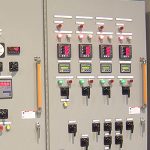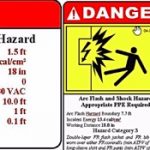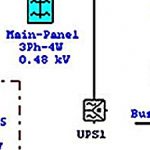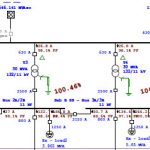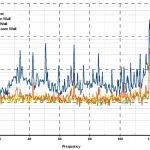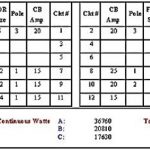
Harmonics are electric voltages and currents on an electric power system that can cause power quality problems. Because equipment and machinery can malfunction or fail in the presence of high harmonic voltage and/or current levels, harmonic distortion has become a growing concern for facility managers, users of automation equipment, and engineers.
Harmonics can cause:
- Circulating currents and high voltages caused by harmonic resonance
- Equipment malfunctions due to excessive voltage distortion
- Increased internal energy losses in connected equipment, causing component failure and shortened life span
- False tripping of branch circuit breakers
- Metering errors
- Fires in wiring and distribution systems
- Generator failures
- Lower system power factor
Why is Harmonic study and Analysis Necessary?
Although the possibility of harmonic problems is narrow, the cases in which they do appear can lead to reduction in power system reliability. Harmonics degrade the level of power quality and its efficiency, particularly in a commercial building or industrial facility. An insight of the potential effects and causes can help avoid harmonic related problems at the design stage and decrease the possibility of undesired effects happening on start-up.
IEEE Std. 519-1992, which is titled “IEEE Recommended Practices and Requirements for Harmonic Control in Electric Power Systems”, Chapter 10 “Recommended Practices for Individual Consumers”, this section is written from the perspective that harmonics must be within acceptable limits at the point where the power system serves more than one customer.
It should be kept in mind that only when the non-linear loads become a substantial portion of the total load, harmonic study and analysis is recommended to predict harmonic levels and identify potential resonance problems regardless of the rectifier pulse number. Most buildings can withstand nonlinear loads of up to 16% of the total electrical system capacity without concern. If the nonlinear loads exceed 16%, some non-apparent negative consequences can result.
In the following cases harmonic study need to be performed:
- If in the design state of a project, if the measure of the nonlinear loads surpasses 25% of the total loads on a bus or a system, a harmonic analysis study is necessary to verify the agreement with the predetermined harmonic limits.
- To solve harmonic-related problems such as failure of electrical equipment or malfunction of protective relays.
- If present plant is expanding and a major amount of nonlinear loads is going to be inserted, then a harmonic analysis study is necessary to check the plant functioning after the addition of these loads.
- If a capacitor bank is added in any electrical system that comprise numerous nonlinear loads, then a harmonic analysis is necessary to verify the probability of resonance occurrence.
What is Done During Harmonic Study and Analysis?
Harmonic analysis or harmonic modelling is an arithmetical method of foreseeing potential resonances and harmonic distortion levels depending on the available power system data. All but the simplest of systems will require a computer to perform this analysis. A number of software packages are available specifically for this purpose.
Equipment like transformers, capacitors and utility system impedance are considered and non-linear loads are represented by several frequency harmonic current sources. Such a modelling study will indicate if harmonic levels will fall within IEEE or utility limits.
Two types of analysis are present in a harmonic analysis and study:
Current and Voltage Distortion Analysis
The discrete and whole current and voltage harmonic distortions are estimated at several buses then the outcome are judged against the predetermined limits.
Impedance versus Frequency Analysis
A chart of the system impedance at different buses is plotted against the frequency. This analysis is important in predicting the system resonances prior to energizing the electrical system. A rise in the impedance plot implies a parallel resonance while a depression in the impedance plot denotes a series resonance.
If harmonic analysis denotes extreme harmonic levels or a potentially harmful resonance condition, there are numerous substitute corrective actions that can be performed.
- Implement a rectifier with a pulse number higher than 6.
- Relocate or disconnect a small amount of power factor correction capacitance to shift a resonant frequency away from a characteristic harmonic.
- Harmonic filters can also be added to the system.
- Implementing a Pulse Width Modulated (PWM) rectifier.
How is Harmonic Study and Analysis Performed?
A harmonics analyser is the best equipment for conducting study and analysis of power quality to find out the wave shapes of current and voltage on corresponding frequency spectrums. A harmonic analyser is also useful in instances where the lack of obvious symptoms prevent you from determining if harmonics are a cause for concern. A harmonics analyser is used to provide a detailed analysis of the suspect source.
Similar to other power systems studies the harmonics study consists of the following steps:
- Definition of harmonic-producing equipment and determination of models for their representation.
- Determination of the models to represent other components in the system including external networks.
- Simulation of the system for various scenarios.
If a harmonic analysis study is required to be performed, the following steps should be followed:
Step 1: Obtain the electrical system one-line diagram and highlight the available nonlinear loads, capacitor banks and medium voltage cables of long length within the industrial system.
Step 2: Focus the place of common coupling (PCC) which is the point that joins the industrial network with the facility or with the adjacent plant.
Step 3: Highlight the in-plant system buses that are expected to be affected from harmonic distortions.
Step 4: Gather the harmonics-related data of all nonlinear loads within the plant.
Step 5: From the utility company, get the important data of voltage and current harmonics at the predetermined PCC including the highest and lowest short circuit fault levels and the permitted limits on current and voltage harmonics because the permitted harmonic limits differ from country to country.
Step 6: Mock-up the electrical network with the help of any of the accessible software like electrical transient analyser program (ETAP).
Step 7: Perform the harmonic analysis for the electrical network at the various possible operating scenarios.
Step 8: Verify whole and discrete levels of current and voltage distortion levels at the concerned system buses and at the PCC.
Step 9: Check the harmonic frequency spectrum, which is a plot of each individual harmonic value with respect to the fundamental value versus frequency.
Step 10: If the harmonic distortion outcome surpasses the permitted levels, chose a suitable harmonic mitigation solution and the best insertion point for that solution.
Step 11: Re-perform the harmonic analysis study after adding the harmonic mitigation technique to ensure compliance with the contractual / international harmonic limits.
Carelabs is authorized provider of Electrical Installation’s Study, Analysis, Inspection, and Certification services in UAE, and offer harmonic acceleration study and analysis services.

